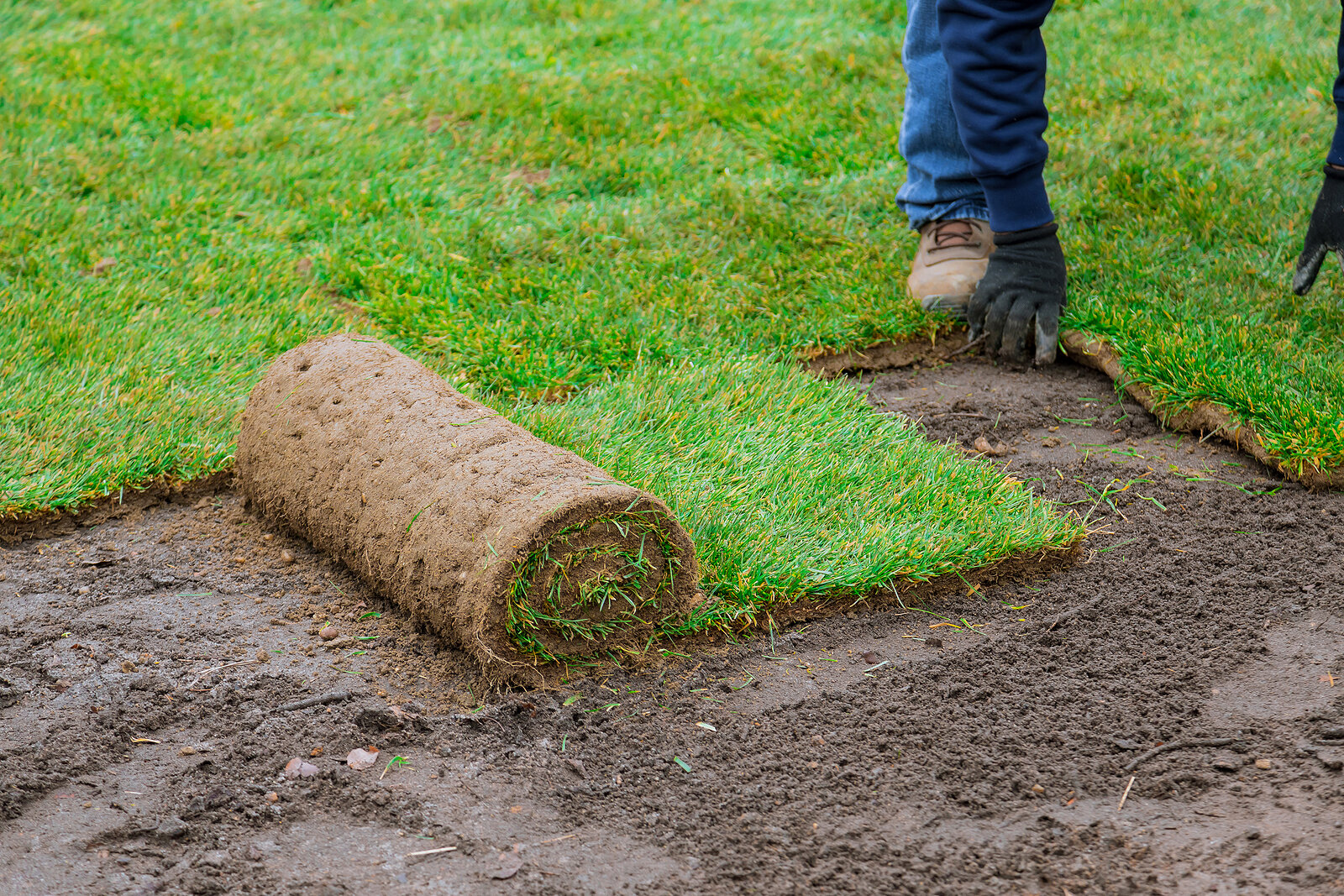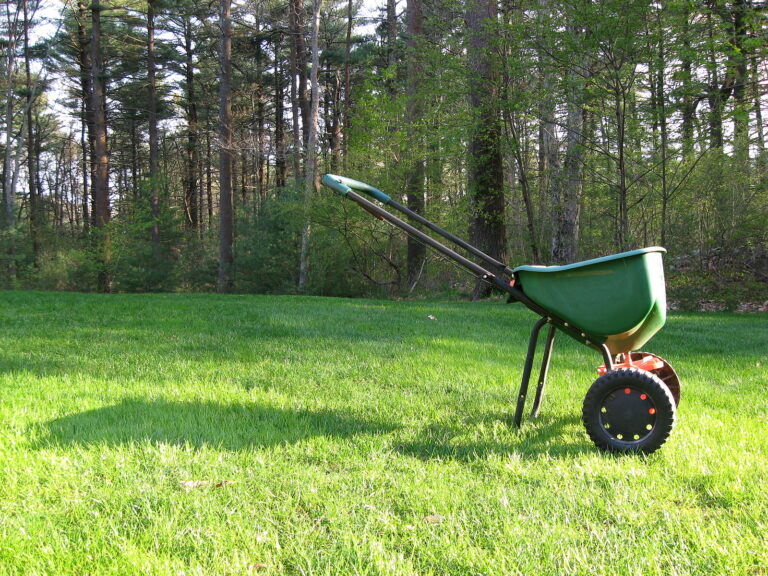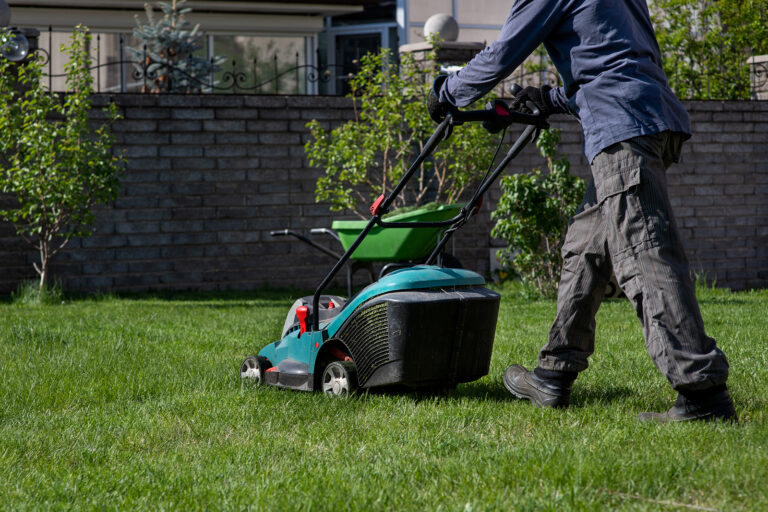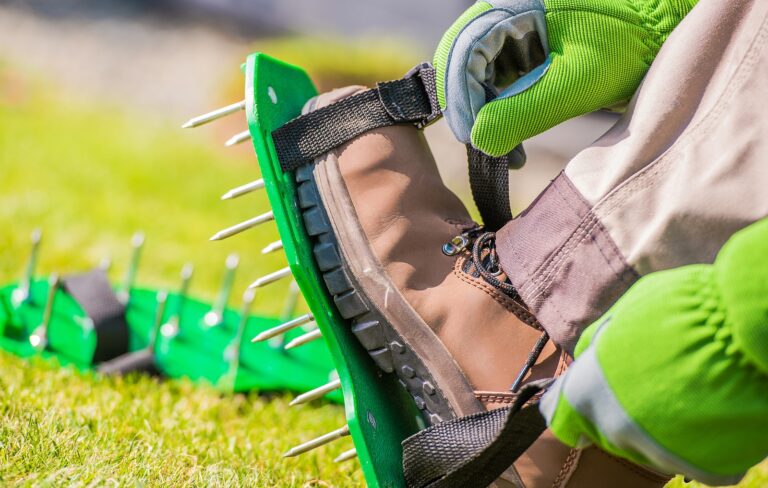How to Plant a Lawn
A lawn can be grown from seed or it can be started by setting out grass plugs or laying down sod.
The way you choose to start your lawn depends on a few factors—the grass you want to grow, the site and climate, and the money you want to spend.
Preparing to plant a lawn is the same whether you start from seed, plugs, or sod.
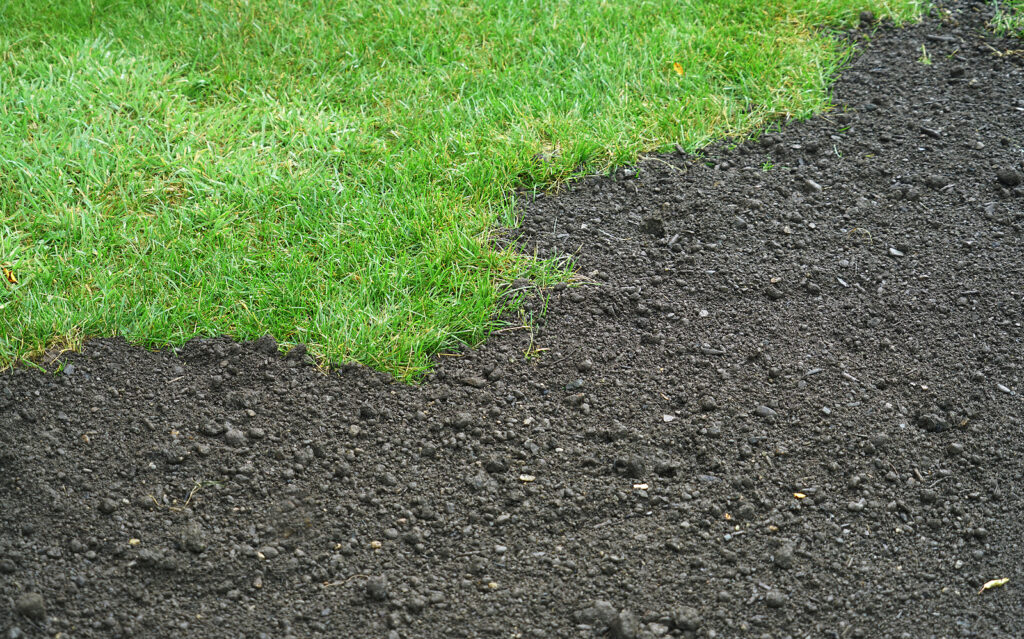
Lawn site preparation step-by-step
- Eliminate Weeds. Before you plant your lawn, check the area for weeds. Every effort must be made to eliminate weeds. Grassy weeds can be particularly troublesome and must be pulled.
- Install Irrigation and Drainage. Install the irrigation system (and drainage system, if necessary) before the final grading.
- Prepare the Soil. Remove debris, rocks, and stones from the site before grading. Slope the soil away from buildings–generally, a 1- to 2-percent slope away from buildings is sufficient. Add topsoil to the site if needed; minimum topsoil depth should be 6 to 8 inches (15-20cm). Allow the soil to settle for 1 or 2 weeks before seeding or sodding. Avoid planting lawns on steep slopes or berms where water will runoff.
- Add Fertilizer to the Soil Ahead of Planting. Apply a starter fertilizer before planting the lawn. Add fertilizer to a depth of 2 to 4 inches (5-10cm).
Seed or sod?
- Seeding a lawn is less expensive than sodding. Seed is more difficult to establish than sod.
- During the time it takes for the seed to germinate and become rooted, the area is vulnerable to erosion and sedimentation.
- Sodding provides nearly immediate functionality. Sod is better able to compete with weeds already in the soil. Growing from seed may require more intensive weeding.
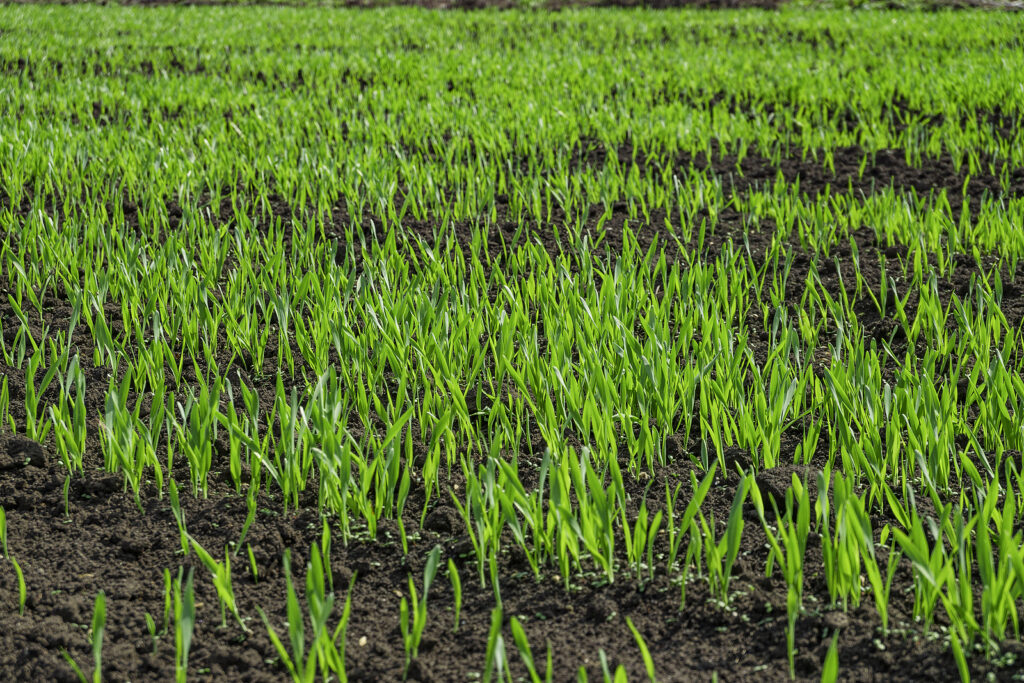
Growing from seed step-by-step
A well-prepared seedbed is essential to establish a lawn from seed. Here’s how step-by-step:
- Test the soil pH and nutrient content. The pH range for most lawn grasses is 6.2 to 6.8. Adjust the pH if necessary.
- Till the bed to a depth of 6 to 8 inches (15-20cm). Add topsoil if needed. Work starter fertilizer into the top 2 to 3 inches (5-7cm) before seedling.
- Rake the soil to prepare a smooth, firm seedbed of loose soil. Smooth out high and low spots.
- Use fresh, name-brand seed. Read the label carefully. The label should list the grasses in the mix—varieties and cultivars. the label should also list the germination rates.
- Sow the seed in two directions perpendicular to each other. Put half the seed in a spreader and go over the area in one direction. Then spread the rest of the seed at a 90-degree angle to the first direction. Use a drop spreader or a broadcast spreader. Avoid spreading seed by hand which can result in waves of seed rather than an even application.
- Cover the seed to a depth of 1/16 to 1/8 inch by raking it in. Then lightly roll the soil with a slightly corrugated roller to ensure the seed makes contact with the soil. The finished seedbed should have shallow uniform depressions made by the rake or the corrugated roller; it should not be perfectly smooth; irrigation will run off a smooth surface.
- Mulch with straw or burlap to prevent the seed from washing or blowing away or being eaten by birds.
- Keep the soil evenly moist during the germination period by applying frequent light irrigations. When seedlings are up, water more deeply and less often.
Germination depends on temperature, moisture, and day-length.
Cool-season grasses such as tall fescue, Kentucky bluegrass, and perennial ryegrass are best seeded in early to mid-autumn or in early to mid-spring.
Warm-season grasses such as Bermuda grass are best seed from mid to late spring.
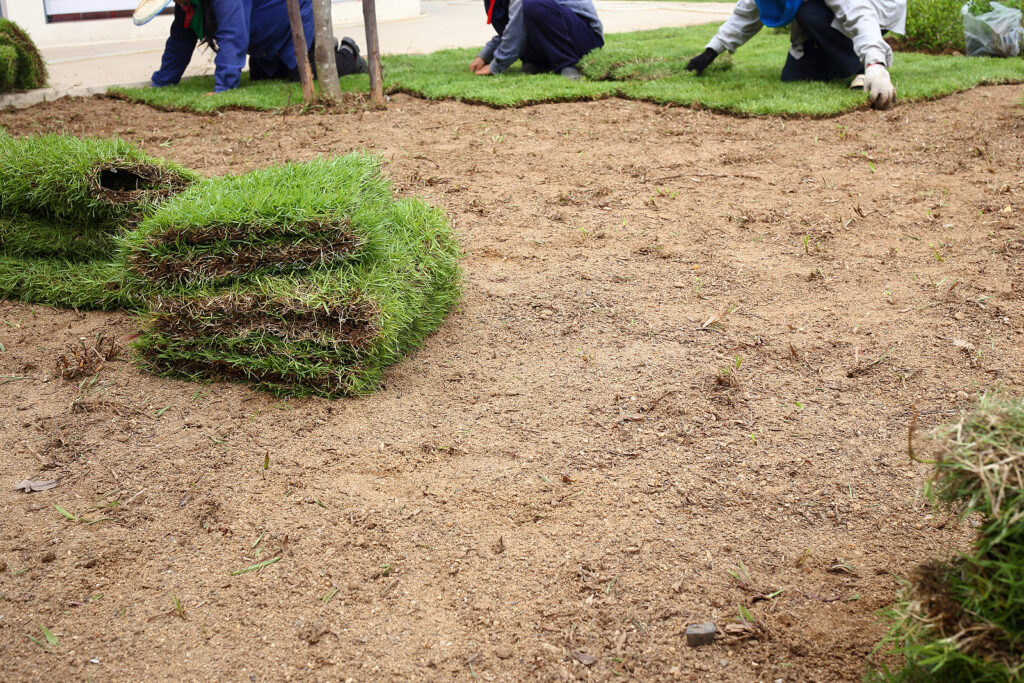
Sodding a lawn
- Soil preparation for sodding is the same as for sowing seed.
- Water the soil before laying sod to avoid setting the roots on a dry surface; this is especially important in hot weather.
- Premium sod will root more quickly than light, good sod. It will also be easier to cut. Avoid sod that is mildewed or has yellowing leaves.
- Install sod quickly after it has been cut and delivered; sod is perishable. Install sod within 24 hours of delivery.
- To install sod, establish a straight line lengthwise through the lawn area. The lay sod on either side of the line with ends staggered. Use a sharp masonry trowel to cut sod.
- Unroll strips of sod and lay them in a staggered pattern (the way bricks are laid). But the edges of the sod strips rightly against one another, but do not overlap them.
- Roll the sod with a roller immediately after it is laid. Keep it moist until it is well-rooted; do not let it dry out.
- Avoid laying sod in very hot or very cold weather. It is best to lay sod when it is actively growing. Late spring and early fall are good times to lay sod.
Starting a lawn from sprigs and plugs
A lawn can be started from sprigs or plugs. A sprig is a grass stem or runner without soil; sprigs are usually 3 to 6 inches long. A plug is a round or square piece of sod that includes rooted grass. Sprigs and plugs are transplanted to the site of the new lawn.
Bermuda grass, Zoysia grass, and St. Augustine grass lawns are commonly established using either springs or plugs.
Here’s how to start a lawn from sprigs or plugs:
- Prepare the soil the same way you would prepare the site for seeding.
- Space the sprigs or plugs evenly across the area. Set spring about 6 inches apart; set plugs 6 to 12 inches apart. Sprigs and plugs can be planted by hand; a specially designed planter can also be used to plant sprigs and plugs.
- Once planted, top-dress the site with a thin layer of planting mix or soil formulated for lawns; planting mixes container nutrients.
Sprigs are stolons. Stolons are runners with roots. They are sprigs. Stolons or sprigs can also be broadcast over an area rather than individually planted. Broadcast the sprigs and then cover them lightly with soil by disking. Root nodes must come in contact with the soil. Stolons are usually sold by the bushel with 1 bushel equivalent to 1 square yare (0.9m) of sod.
The best time to plant a lawn from sprigs or plugs is mid to late spring into early summer.
Watering the new lawn
- New seedlings and stolons need frequent light irrigation to ensure that roots become established.
- Keep the soil moist, but not wet for 30 days after planting.
- During hot weather, make 3 or 4 light waterings each day. If the soil dries out during germination, seedlings, sod, sprigs, or plugs are likely to die.
- Keep the soil evenly moist until growth begins, not wet, not dry. Sod should be heavily watered every second or third day to ensure the soil beneath the sod is moist to 6 inches (15cm) deep. Keep lawns planted with seed, sprigs, or plugs evenly moist, not saturated.
Also of interest:

